Ice Hockey for Late Starters
How to pick up ice hockey and get started
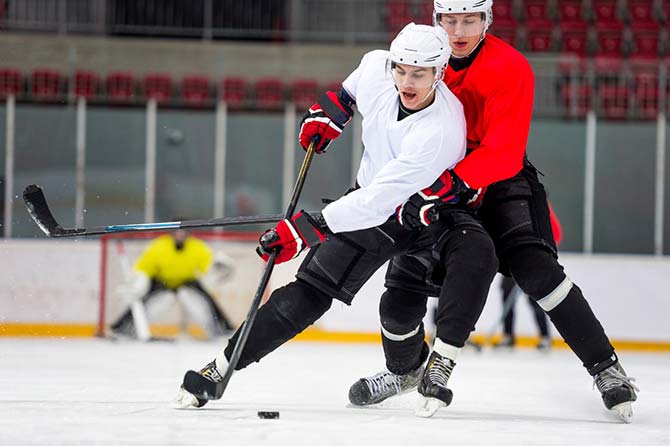
Picking up hockey as an adult? Want to join a club or team? Together with Felix Schmid, the ice hockey coach of the Freiburg Vikings, we'll explain what new players should be able to do before their first game and which exercises are best suited for beginners.
Picking up hockey as an adult? Want to join a club or team? Together with Felix Schmid, the ice hockey coach of the Freiburg Vikings, we'll explain what you should be able to do as a beginner and which exercises are suitable for new players.
Ice hockey for late starters
You'd love to play hockey but are afraid that it's too late? Even as an adult it's worthwhile to learn a new sport or to refresh old knowledge. In any case, newbies or returning veterans in ice hockey should be "excited to get on the ice", says Felix Schmid, ice hockey coach of the Freiburg Vikings, and stresses that a beginner "shouldn't be deterred by the first step: just getting on the ice." At the same time, in order to seriously pursue ice hockey as a hobby, "a sense of balance, body control and a physical toughness are essential".
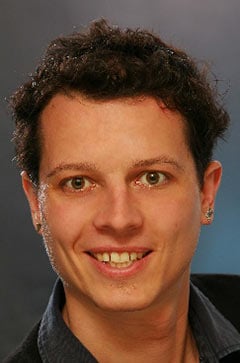
Felix Schmid, coach of the Freiburg Vikings
Felix Schmid works as a teacher for sports, Latin and biology at a grammar school. He is the 2nd chairman and coach of the Vikings Freiburg e. V. hobby ice hockey team. He started playing hockey at the age of seven, then coaching the junior players at the EHC Freiburg, where he has been for the past 10 years.
League games with the EHC Freiburg have taken him all across Germany. On top of that, he also played for the Baden-Württemberg selection for two years. After a short hiatus due to his studies, he pick up the game again to play for the university team, the Freiburg Vikings. Since 2015 the Freiburg Vikings are now officially registered as a ice hockey club.
The Freiburg Vikings e.V.
Members of the Vikings come from a wide range of different backgrounds, ranging from amateurs to former 'Oberliga' (3rd national league) or 'Bayernliga' (regional league) players, as well as students and non students of all skill levels.
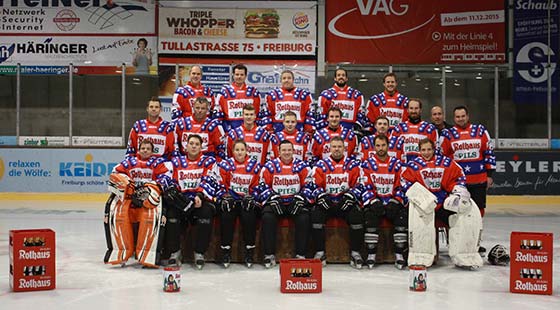
The Vikings don't train complete beginners, however. If you want to play with the Freiburg Vikings "you need to skate well and have good puck handling skills.".
Requirements for learning ice hockey
The most important prerequisite for playing ice hockey is being able to skate. You should feel comfortable in your skates, moving across the ice should feel natural and you should be able to start and stop on a dime. This will require hours of practice, but it will definitely pay off once you start playing! Most ice rinks have an hour a day where they are open to the public. It is also important that the skates are neither too tight nor too big.
Tip: By the way, the best time to try on skates is in the afternoon, as feet tend to be swollen in the evening, and shrink over night.
If you've just started skating or don't yet have the hang of starting, stopping and gliding, then these practical tips from ice hockey professional Leon Niederberger should help you:
Tips for late starters
According to Felix Schmid, ice hockey beginners can still train successfully as adults: "You can also learn the technical and tactical skills as a late starter and reach a certain skill level with the appropriate training."
However, he also points out that adults who are just starting out may find it difficult to acquire a proper understanding of the game. This creates certain obstacles: "Ice hockey is the fastest team sport in the world and without an understanding of the game you just fall behind. Here, previous experience is key. Experience in football is not very useful, but experience in handball or basketball gives a head start."
Does ice hockey pose a risk to injury?
According to coach Schmid, hobby players have a reduced risk of injury compared to professional players: "Hobby players usuall play without hard body checks. This significantly reduces the risk of injury. Overall however, ice hockey does not have higher injury rates than handball or football, even in professional leagues."
Start playing ice hockey: Exercises for late beginners
Beginners and hobby players alike should practice constantly if you want to improve. Even at home or at a frozen lake over the weekend.
Ice hockey exercises for getting down the basics
"Physically, ice hockey is essentially determined by the three conditional abilities: strength, endurance and speed. For the goalkeeper, strength plays less of a role, but mobility is crucial" , Schmid says. In order to create a solid foundation for playing ice hockey, the Vikings coach says that "the exercise to improve performance is jogging.
Hockey exercises at home
An ice rink is hard to gain access to or just come across, so getting in needed training session is even harder. The seasonality of ice hockey and small rink hours are further obstacles. "If you don't have access to an ice rink in the summer, inline skating is a good alternative. Despite there being significant differences to ice skating (braking for example), many things are the same (starting, cross over when turning, tight turns, balance...)"" advises Schmid.
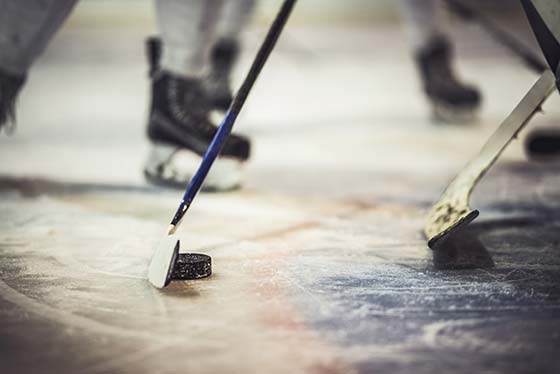
How do you make a tight turn?
A tight turn is made with slightly offset skates. The inside skate is in front. A left turn means left foot in front and knees slightly bent, outer edge on the left skate, inner edge on the right, and vice versa. Your shoulders should face the direction of travel and your body should lean into the turn slightly. (skip to 00:24 min)
In addition to a proper skating technique there are "many exercises that improve stick control, which can also be done at home with a tennis ball," advises Felix Schmid. For example, you can practice at home not to look at the puck when you have possession, to use the upper hand on the ice hockey stick to steer the puck and to keep the puck moving at all times.
In addition to cardio, make sure to do strength training.
Strength exercise I: Dumbell squats
Stand up straight with feet shoulder width apart, dumbbells at your hips with palms facing inwards. Now bend your knees slowly, keeping your back straight and your thighs horizontal. Then stand up. Repeat this for three sets with 10 repetitions each. If the exercise with dumbbell is too difficult, practice without dumbbells.
Strength exercise II: Forwards and backwards lunges
Stand up straight; your feet at shoulder width. Place your arms behind your head; Take a big step forward with your right foot and bend with your right knee until your thigh is horizontal. Then go back to the starting position and repeat with your left leg. This is how you do the forward lunge. The backwards lunge works the same, except you take a step backwards. We also recommend doing push-ups, chin-ups and going for bike rides. To strengthen your back, visit a local gym.
Ice hockey exercises for the ice
When training on the ice "there are two things you need to master: skating and stick handling. Felix Schmid recommends the following exercises in the ice rink:
- Ice skating: "Skating around the faceoff cricle in either direction, forwards and backwards with crossovers."
- Stick handling: "Dribble the puck while standing still or while moving without looking at the puck".
If you want to burn some serious energy on the ice, you can also bend your knees when skating and quickly straighten up again. If you repeat this regularly, you'll improve both strength, and endurance. Once you feel confident about skating and turning, you can practice faster, tighter turns.
Tip: Once you've mastered skating and stick handling, our article on the proper shooting technique will help you to further hone your skills.
Best Practice: 15 exercises for the ice
We have the right exercises to prepare you for your first game! The most important prerequisite for all exercises on the ice: You are able to skate safely - forwards and backwards!
The types of training can be broken down to 4 types:
- Type 1: Balancing exercises on skates
- Type 2: Balancing with the ice hockey stick
- Type 3: Changing direction and stick control
- Type 4: Quick turns, directional changes and pushing off.
With these skills under your belt, you are ready for lessons on checking.
Exercise 1: Stopping
Skate forward and (try to) stop on a dime. Skate backwards and do the same. If this works well, try one legged stopping forwards and the same for backwards. (Type 1)
Exercise 2: Hip Opener
For this exercise you need four pucks and you must be able to stop with one leg. You can see the exercise in the following video. (Phase 3)
Exercise 3: Aggressive Starts
From a standing position, burst forwards. If this works quite well, start moving backwards from a standing position. (Type 1)
Exercise 4: Squat Balancing
Squat down as low as possible, stay down and keep your balance. If this works reasonably well, take your stick with you and hold it over your head while doing the exercise. (Type 1)
Exercise 5: Squatting
Perform squats on the ice and fully extend on your way up. Keep your balance here too. (Type 1)
Exercise 6: Puck Control
Guide the puck across the ice without staring at the puck. (Type 2 and 3)
Exercise 7: The Toe Drag
Start with the puck to the side and behind you. With your head up, bring the puck through your skates to the front. The upper hand is firmly on the stick while the lower hand is loose. (Type 2 and 3)
Exercise 8: Stick handling in close quarters
Skate quickly in a small circle while guiding the puck in a very tight space. (Type 3)
Exercise 9: Find a buddy
With a partner, pass the puck to each other while moving forwards or backwards. (Type 3)
Exercise 10: Shooting
Both shooting technique and strength are crucial in order to score goals. In our article "Shooting technique, Slap Shot & Co.", you can read up on how to improve your shot.
How are some steps that will help you improve your shot:
- 1. Shoot from a standing position with your forehand.
- 2. Take the puck from a pass and shoot it on goal.
- 3. Take the puck from a pass on your backhand and transition and shoot with your forehand.
- 4. Skate forwards to a lying puck and shoot it on the fly.
Exercise 11: Slalom
Ride on the inside and outside edges of your skates in a slalom fasion on the ice. For added difficulty, try it backwards. (Type 3 and 4)
Exercise 12: C-Run
Skate a "C" on one leg and then switch to the other leg. (Type 1 and 4)
Exercise 13: Running
Play the puck while crossing over. Brake and then start again. (Type 2 and 4)
Exercise 14: Backwards and Forwards
Practice switching between skating forwards and backwards. The fast the switch, the better.(Type 4)
Exercise 15: Fighting off defenders
This exercise only works with a partner. Skate with the puck while the opponent approaches. Now try to skate by the opponent. When you get close, bend your knees to lower your center of gravity. A strong core will help with this. The stick should stay on the ice while you push past the opponent. Now protect the puck as you clear yourself from the opponent. (Type 4)
Which position in the team is particularly suitable for beginners?
It might sound strange, but beginners are best forwards, according to Felix Schmid. He explains why: "Hockey is played with 3 forwards, two defensemen and a goalie. A beginner as a forward is less of a disadvantage than a beginner as a defender."
So that you don't make too many mistakes in your first game, you should be familiar with the rules of ice hockey and train regularly. We hope these professional tips help you improve your game!
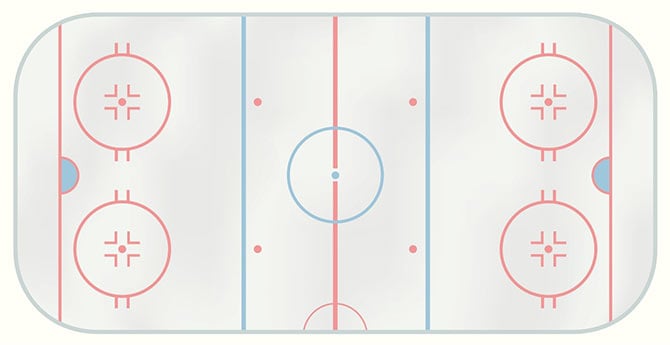
Is the practice paying off?
Beginners who've mastered the basics will be prepared for their first games. This includes passing, shooting, turning and braking. Once you have a bit more experience under your belt, you can continue developing your positioning game.
Last but not least, a big thanks to Felix Schmid for the interview, the helpful tips and ice hockey drills!
Image rights: Title: © gettyimages.de / technotr; Image 2: © Felix Schmid; Image 3: © Vikings Freiburg e.V.; Image 4: © gettyimages.de / Hemera Technologies; Image 5: Screenshot VBG; Image 6: © gettyimages.de / artisteer;